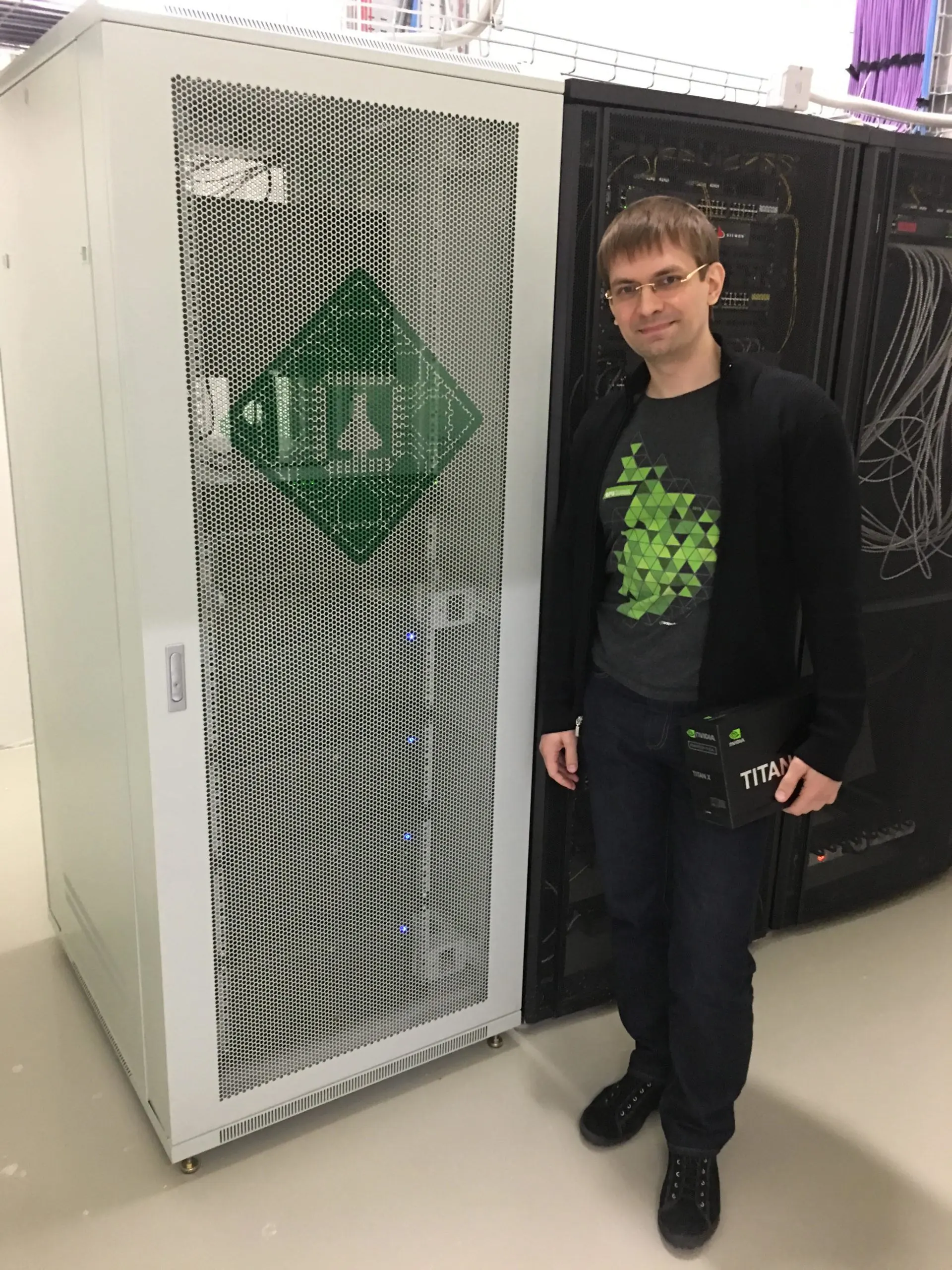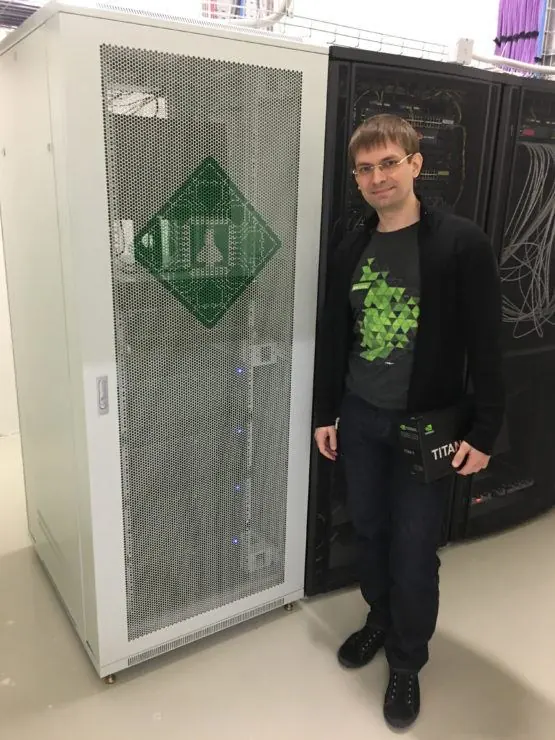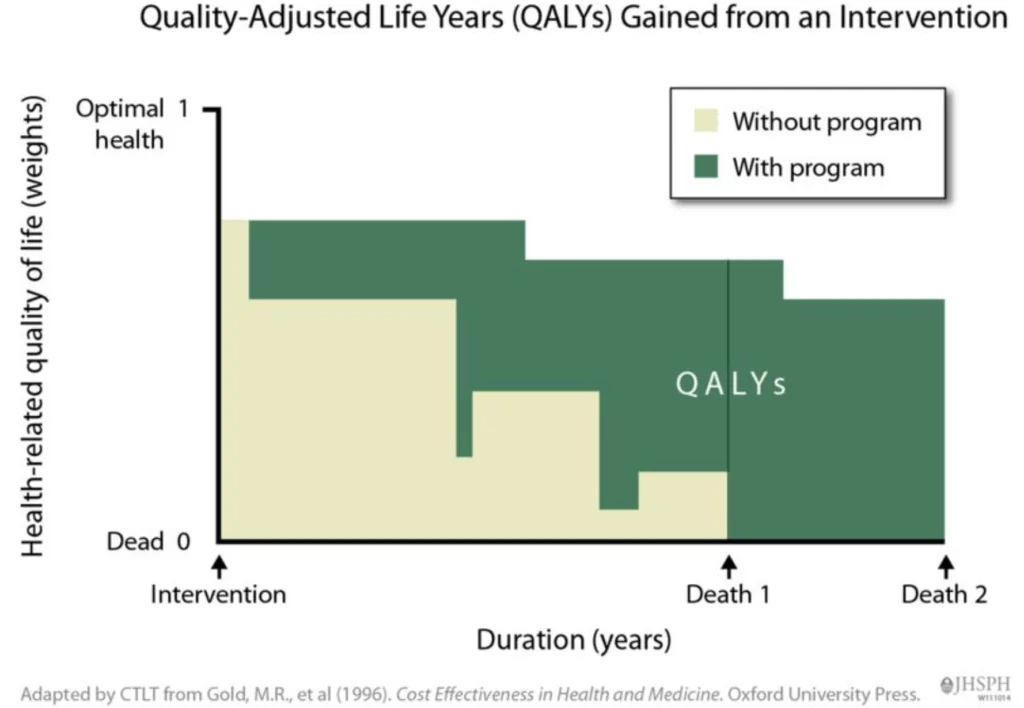The battle against aging is not going to be an easy one, and it will likely require the most refined tools modern science has to offer. Among them, artificial intelligence may be one of the most promising and is being extensively used by biogerontology researchers such as Dr. Alex Zhavoronkov.
Boasting an impressive collection of degrees—among which a Ph.D. in biophysics, an MSc in biotechnology, and a BA in Computer science—Dr. Zhavoronkov has had an equally impressive career in the fields of biogerontology and regenerative medicine. He is the director of IARP—the International Aging Research Portfolio—and of the UK-based charity Biogerontology Research Foundation.
For several years now, he has been head of the Regenerative Medicine Laboratory at the Centre for Pediatric Hematology, Oncology and Immunology and adjunct professor at the Institute of Physics and Technology in Moscow.
Since 2014, he’s also the CEO of Insilico Medicine, a bioinformatics company which he co-founded. The company, which was awarded the ‘Most Promising Company’ title at the Palo Alto Personalised Medicine World Conference in 2015, focuses on extending healthy longevity using A.I. to discover new drugs and develop biomarkers for aging.
One of its most notable projects is OncoFinder, an algorithm used to analyze the activity of molecular pathways involved in both normal and pathological conditions, from growth and development to aging and cancer. The algorithm can be used to predict which drugs could prove the most effective in the treatment of cancer, for example, or to determine which pathways are involved in age-related diseases.
Dr. Zhavoronkov is a longevity enthusiast and he believes we can push the longevity record past the current 122 years.
Poised for a revolution in rejuvenation research
He compares the current state of radical life-extension research to that of computer science in the late 70s, when all the building blocks of the upcoming revolution were either in place already or about to be. To maximise his odds to see the dawn of rejuvenation biotechnology, Alex maintains a strict, healthy regimen that includes regular exercising, monitoring his health conditions and a variety of drugs and supplements tailored to his specific situation.
His current ambitious yet achievable goal is to reach 150 years of age, and he certainly does not think it would be boring to live for that long. He argues life should never be boring and that the way to go to avoid it is finding research interests and passions to motivate oneself.
In fact, he further argues, the major challenge to overcome to defeat aging is represented by psychological aging—the tendency people have to accept the decline that comes with age and the changes in behavior and attitudes that this imposes on them.
This aspect is one of the topics he discussed in his book The Ageless Generation: How Advances in Biomedicine Will Transform The Global Economy. Together with an ever-growing number of specialists of the field, Dr. Zhavoronkov endorses the idea that aging is nothing but a complex, multifactorial disease, and that it should be officially classified as such.
Whilst we haven’t brought the aging processes under medical control yet, Alex thinks it is possible, and that eliminating the pain and suffering that currently characterizes late life is a worthy and achievable goal. Already today, he argues, people who are reasonably healthy in their 70s stand a fighting chance of living past 150.
We took the opportunity to catch up with Alex and ask him a few questions about his work and the field of aging research.
Hi, Alex, could you begin by explaining what first attracted you to science and in particular the study of aging and why you believe aging is a problem to be solved?
Since very early childhood I asked myself one question: “Why in Star Wars, Star Trek and other Sci Fi movies and books people invent space travel, medical droids and other marvelous technologies, but still grow old, age and die?”. In order to go into space for the extended periods of time, one would need to live longer and be resistant to all kinds of stress including radiation. Plus, I had a crush on Madonna and really did not want her to age and there are many other reasons.
One reason above all is that there is no point in living if you can’t keep continuously improving no matter how hard you try. People, who accumulate wealth do not really own anything, they rent assets for as long as they live. But before going all-in into biomedicine, I went into computer science, did my first bachelor degrees at Queen’s University in Canada and made some money to ensure that I can sustain for a few years and support my own research.
I went into high-performance computing and managed to get into the high-level position at a graphics processing unit (GPU) company called ATI Technologies at a reasonably young age fifteen years ago. When I reached a reasonably comfortable financial situation, I decided to quit and went to do my graduate work in biosciences looking for ways to extend healthy productive longevity. I worked in a number of areas related to aging research and along the way, I got my masters and Ph.D. degrees, got two laboratories and worked for a number of biotechnology companies.
In 2010, after a decade of education and research, I realized that aging is a very complex multifactorial process and that humans are very different from model organisms. And we need to focus on developing the core technology that can be used to build a sustainable business around aging research so that it can unfold and demultiplex into many directions to prevent the transformation of aging into a disease.
Since January 2014 I have been running Insilico Medicine, which takes an umbrella view on the field with over 170 research projects and over 150 collaborators worldwide. I have no doubt that aging is a problem that can be solved within our lifetimes unless we see a major economic crisis, a global war, or both.
Your work focuses on computational medicine, how would you explain this relatively new field of science to our readers?
Computational biomedicine is a very broad field of research, where computational methods and tools are applied for diagnosis, treatment, and research. The field has been around since the invention of electronic analytical equipment, but in recent years it got a major boost due to the availability of Big Data, increases in computing power, breakthroughs in machine learning and convergence of the many fields of science and technology.
You are the CEO of Insilico Medicine. What are the main goals of the company for the next 5 years? Can we expect breakthroughs in personalized medicine?
Our long-term goal is to continuously improve human performance and prevent and cure the age-related diseases. In 5 years we want to build a comprehensive system to model and monitor the human health status and rapidly correct any deviations from the ideal healthy state with lifestyle or therapeutic interventions. Considering what we already have, I hope that we will be able to do it sooner than in 5 years.
One reason why we can manage over 170 projects is that we use agile development practices and approach every project as a software development project. We treat aging as a salami, constantly “cutting” thin slices and I think we are halfway through. In 5 years you can definitely expect breakthroughs in personalized medicine and we are not the only company working in the field, so there will be many breakthroughs on the many fronts.
The main breakthroughs I can promise from Insilico are in the area of multimodal biomarkers of aging, where we take as much data available for an individual from simple pictures and regular blood tests to very expensive molecular and imaging data and turn it into a model, which can be used to make a broad range of predictions, recommendations, and treatments. We are entering the era of personalized drug discovery and regenerative medicine.
One of our major contributions to the field was the application of deep neural networks for predicting the age of the person. People are very different and have different diseases. But if you want to find just one feature, which is biologically relevant and can be predicted using many data types – it is the person’s date of birth.
So we build all kinds of predictors of chronological age and then look at what features and at what levels are most important and can be used to infer causality and be targeted with interventions. I think that this approach is novel and will result in many breakthroughs. Here are the two slides that illustrate this idea:
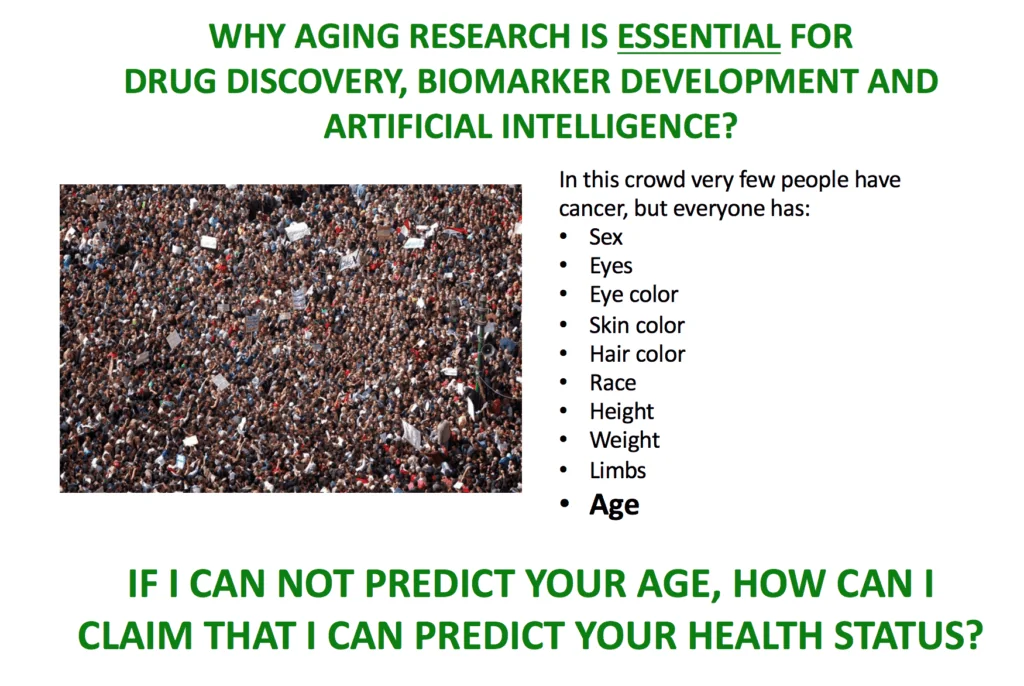
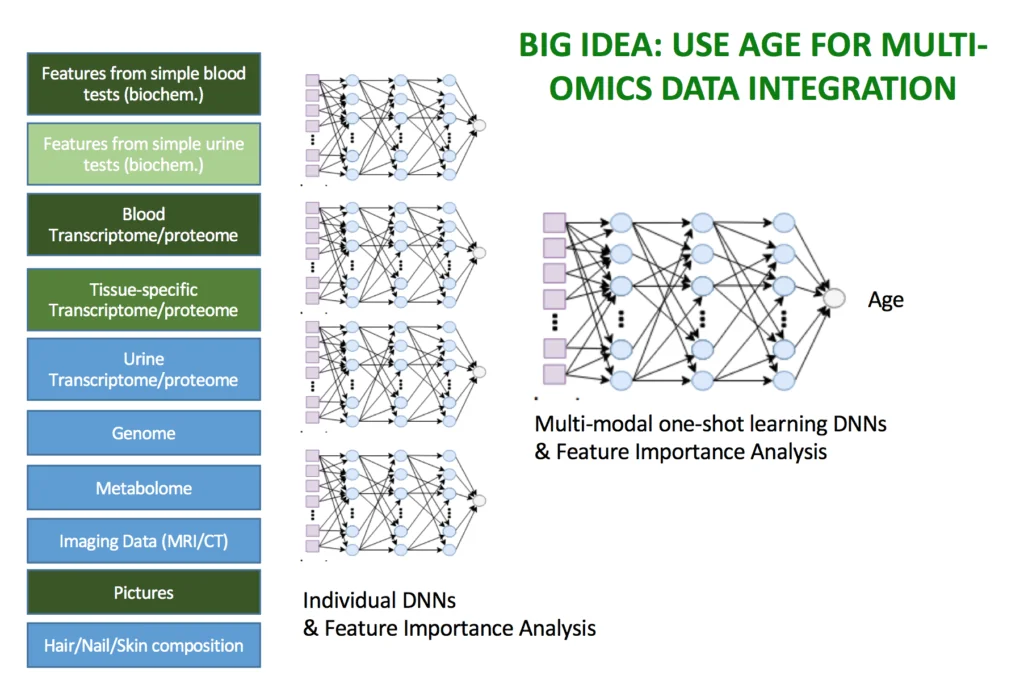 Another set of breakthroughs is likely to come from our work in the generative adversarial networks (GANs) and reinforcement learning (RL), where we are experimenting with the design of new molecules with the desired properties and reconstruct the incomplete data sets with missing values. Here is a public version of our current drug discovery pipeline:
Another set of breakthroughs is likely to come from our work in the generative adversarial networks (GANs) and reinforcement learning (RL), where we are experimenting with the design of new molecules with the desired properties and reconstruct the incomplete data sets with missing values. Here is a public version of our current drug discovery pipeline:
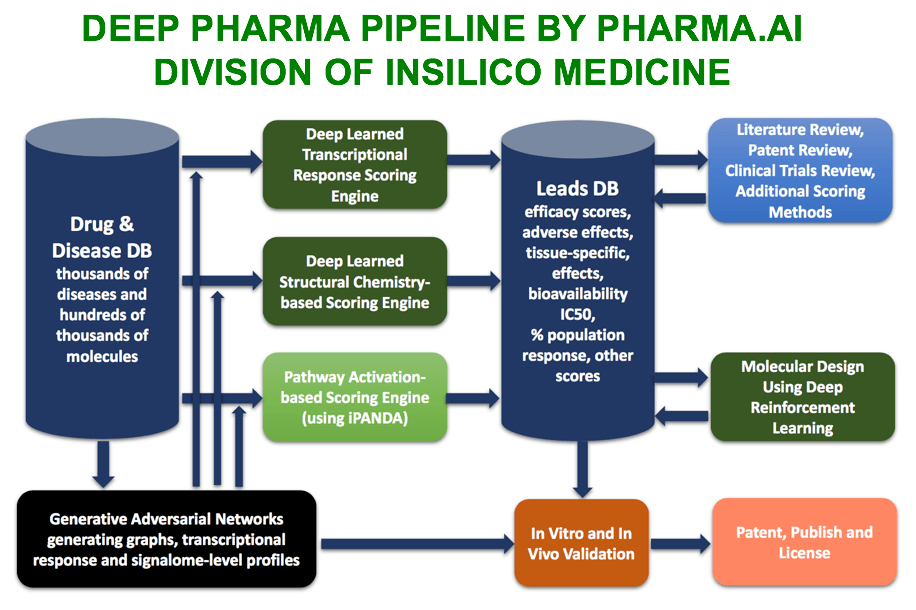 We published some of the proofs of concept for at least some of these steps so that other people could go this route and to save time when explaining this approach to our partners in Big Pharma.
We published some of the proofs of concept for at least some of these steps so that other people could go this route and to save time when explaining this approach to our partners in Big Pharma.
How do you decide what projects to get involved in?
The way we prioritize projects at Insilico Medicine is by looking at the number of QALY each project can generate. Most pharmaceutical companies, governments, and philanthropists do not realize that aging research generates the maximum number of QALY per dollar spent. It is the most altruistic cause and the most effective investment.
If you add just one year of life to everyone on the planet, you generate over 7 billion QALY. The average reasonable cost per QALY is around $50,000. So it is possible to generate several hundred trillion dollars by extending the life of everyone on the planet with a simple intervention.
Will you tell us a little bit about your team at Insilico? Is it easy to get on board or do you have some sort of test?
Over the past two years, we hire through hackathons and mini-competitions that we either organize or support. Several of our core deep learning specialists and bioinformaticians were hired in this manner. We also work with the young bright scientists, who come to us looking for a project.
We usually give them a difficult or impossible task and if they come up with a solution, we integrate them into the team. We usually want to ensure that the person is not driven by the monetary aspect of employment and will stay with us for over a year. And sometimes we allow and even encourage the person to remain part-time in academia.
Today we have R&D resources in Baltimore, Brussels, Moscow, St. Petersburg, Oxford, and Seul. This year we will try to grow Insilico Korea, conduct one or two SkinHack hackathons using our AgeNet.Net system and establish closer collaboration with the partners in Korea. We also like hiring people in Russia. The level of programming talent is very high, people are loyal, curious, dedicated and mission-driven.
And if you have any negative feelings with regards to Russia, remember that there are several countries considered to be friendly that are actually kingdoms. So you need companies like ours with strong humanitarian values to create new industries and reduce the country’s dependence on oil.
We have heard you make your team members pass a course on bioinformatics to join the Longevity Pride club, can you tell us a bit more about that?
All team members join voluntarily and usually through hackathons or collaborations. Longevity Pride is more than a club or a fraternity. It is a philosophy centered around the idea that we can model the human biological processes so well that at some point in time we could develop personalized interventions that are safe and effective.
We are a community of like-minded individuals with strong background in IT or bioinformatics, who embrace the computational approach for extending healthy human longevity. We have a code of conduct, a specially-designed ring. It is not a secret society. But if you see someone with a ring of this design, the person is likely to be very good in bioinformatics and is contributing to aging research.
How would you advise someone interested in working in computational medicine to get involved?
I recommend going to a few conferences on aging and AI. This year I co-organized two innovation forums during the EMBO/Basel Life conference (www.BaselLife.org): 4th Annual Aging Research for Drug Discovery Forum and 1st Artificial Intelligence and BlockChain Technology in Healthcare Forum 11-13 of September 2017.
If you want to get a very long introduction to aging research in the context of effective altruism, a few ideas on how to get involved, Insilico and economics of aging and longevity, here are the slides from a 2-hour presentation I recently gave to a group of IT students:
You have already used your approach for cancer with the OncoFinder study[1-2]. This seems like a radical new way of conducting research, how successful has this method been so far?
The OncoFinder demonstrated excellent results in helping personalized existing treatments for individual patients and improve clinical trials enrollment practices. But for drug discovery, we developed tools like the iPANDA algorithm and its derivatives to track the minute changes between the various signaling states in multiple tissues and identified the molecules that can target these changes. Some of these molecules have been licensed to professional drug developers and some are being validated by the contract research organizations (CROs) for Insilico Medicine.
Can we apply the lessons learned from OncoFinder to the various aging processes to treat age-related diseases for example? After all cancer and aging are closely connected right?
Yes, that was the original idea. We developed a set of highly sensitive differential pathway perturbation analysis algorithms like the OncoFinder and the iPANDA to understand the minute changes between the young healthy state, old state and diseases like cancer. The iPANDA is an excellent tool for the biologically-relevant dimensionality reduction for the training of the deep neural networks.
Aging and cancer are very closely related and cancer is the age-related disease. However, one of the reasons we study cancer is because tissue-specific cancer is a very good model for validating our biomarkers and drug scoring algorithms. Many other diseases are systemic and affect multiple tissues and it is very difficult to perform validation on human tissue.
AI is a very hot topic right now and its potential use in medicine, and of course you are heavily involved in that yourself [3]. Do you think AI could help us to bring aging under comprehensive medical control?
I think that applying AI to aging is the only way to bring it under the comprehensive medical control. Our AI ecosystem is comprised of multiple pipelines. With our drug discovery and biomarker development pipelines we can go after almost every disease and we even have several projects in ALS.
While our proof of concept studies are usually done in cancer, because it is easier to validate the predictions, we go after many disease areas. And since we are considering aging as a form of disease, many of the same algorithms are used to develop biomarkers and drugs to prevent and possibly even restore the age-associated damage.
Our technology also adds credibility to aging research for the pharmaceutical R&D. For example, some of the most significant breakthroughs in modern medicine were made in immuno oncology, where the patient’s’ immune system is used to attack the tumor. Many pharmaceutical companies that run clinical trials cut off enrollment into the clinical trials by age, so older patients will not be eligible.
We have many tools to evaluate the immune fitness of the patient and tools to boost the response rate to the immuno oncology drugs. Understanding aging in this context is extremely important, otherwise many patients will be left behind. According to recent studies, it may take up to 17 years to bring a new treatment from a lab to market, and the price of such an adventure can make around $2 billion.
The main problem with the current pharmaceutical drug development model is not the time from a lab to market, but the lack of ideas resulting in cures and the high failure rate. It costs on average $2.5 billion to develop a drug. This is primarily due to a large number of failures in clinical trials. In oncology, the success rate is ~5% and Phase II is the riskiest area. In many other therapeutic areas, there are no products resulting in complete cures.
The main costs are in clinical trials because of the lack of effective in silico tools and due to the poor translation from animal models to humans. And this is where I disagree with the many other scientists in aging research. If we see 95% failure rate when taking drugs that show both safety and efficacy in mice into humans in oncology and other fields, the probability that some of the completely new drugs developed to address aging in mice, are likely to have a higher failure rate.
To address this we need two things: 1. work primarily with human data for drug and biomarker development and 2. we need a very sensitive and accurate system to perform a cross-species analysis. Therefore, our short term goal is not to necessarily shorten the time but to increase the probability of the molecule passing the clinical trials and resulting in a cure or substantial amelioration of a disease.
Once the regulation of drug approvals adjusts for the advances in AI, it may be possible to significantly accelerate the process, but right now it is important to increase the success rate.
What is your estimate, when we could expect the first powerful treatment to slow down aging appear on the market? By powerful we mean, preventing some age-related disease and extending life by 10 years? What aging process will be addressed first?
I think that there are several very powerful treatments that are already available on the market and to get the extra 10–20 years or even more we just need to devise a way to turn these into therapeutic regimens. I think that a comprehensive regimen involving metformin, targeted rapalogs, senolytics, anti-inflammatory agents, aspirin, NAC, ACE inhibitors, beta-blockers, PDE5, PCSK9 inhibitors, NAD+ activators and precursors in combination with regenerative medicine procedures and also a set of cosmetic and lifestyle interventions could easily add 20 years to our life span. And I am sure that some people are already trying these interventions on themselves.
Unfortunately, nobody is tracking this data. I also hope that some of the interventions will be developed by our team. We apply our drug discovery pipelines to identify the compounds that are much more likely to pass through clinical trials and result in substantial health benefits. We also provide a set of companion biomarkers to ensure that we do not enroll patients, who are not going to respond to therapy.
In terms of addressing the specific aging processes, we are addressing the three low-hanging fruits. We found new mechanisms for clearing out the senescent cells and manipulating a few other cell-states in a very creative way and in a tissue-specific manner. We also found the new tools to go after several types of fibrosis. And finally, we have a few molecules to induce the endogenous repair processes.
Over the past few years, we saw many high-net worth individuals announcing their intent to focus on aging. Google launched Calico, Facebook announced a program to cure all diseases within this century, Peter Thiel is supporting the SENS Foundation and sponsoring blood transfusions from young to old patients. What do you think of this trend?
It is not surprising that the majority of the high net worth individuals supporting longevity research come from IT. In just three decades they transformed our lives beyond recognition. What is surprising is that there is so few of them and that they hire “old school” scientists and business people to run their initiatives instead of actively getting involved. The US government alone spends over $40 billion dollars annually on biomedical research through the NIH, NSF, DOE and other funding bodies, with just the National Institute on Aging spending over $1 billion every year for many years.
While we see many promising results from these government-funded initiatives, the contributions Google, Facebook, Oracle, and others could make if they really focused their efforts and applied their own minds to aging research, could be much greater and more disruptive. Putting slightly more resources in the hands of the scientists, who are doing science for the sake of science is not going to result in any dramatic changes or acceleration.
What we need is Facebook and Google brains working on the problem of aging in a disruptive way. And that is why I think that even within the Google universe, Verily is likely to contribute more to extending productive longevity than Calico. Unfortunately, they are not positioned as an anti-aging company.
As the high net worth individuals (HNWI) go, I really like Jim Mellon’s approach. Before he announced his intention to invest in the longevity business, he personally went on a long road trip visiting dozens of laboratories in the US and Europe and wrote a book called “Juvenescence”, where he described his vision and invited other people to invest. He really took the time and took a deep dive into the industry, technology, and people before making the bets. I think that the other HNWIs should follow Jim’s example each in their unique way. I am not sure about the space race, but a race for longevity among the HNWIs could transform our lives for the better.
Conclusion
We wish to thank Dr. Zhavoronkov for taking the time to do this interview with us and for providing such detailed and interesting answers about the exciting world of A.I. and research.
You may also be interested to learn that Dr. Zhavoronkov and the team he is part of are currently hosting the Mouseage project on lifespan.io, a project that aims to create a photographic biomarker of aging in mice using the power of machine learning. The goal of this project is to help speed up aging research and save the lives of animals. You can make a real difference by donating, helping them to create a valuable research tool and improve the lives of animals sooner. Visit the Mouseage campaign today and show your support.
Literature
[1] Buzdin, A. A., Zhavoronkov, A. A., Korzinkin, M. B., Venkova, L. S., Zenin, A. A., Smirnov, P. Y., & Borisov, N. M. (2014). Oncofinder, a new method for the analysis of intracellular signaling pathway activation using transcriptomic data. Frontiers in genetics, 5, 55.
[2] Artemov, A., Aliper, A., Korzinkin, M., Lezhnina, K., Jellen, L., Zhukov, N., … & Buzdin, A. (2015). A method for predicting target drug efficiency in cancer based on the analysis of signaling pathway activation. Oncotarget, 6(30), 29347.
[3] Aliper, A., Plis, S., Artemov, A., Ulloa, A., Mamoshina, P., & Zhavoronkov, A. (2016). Deep learning applications for predicting pharmacological properties of drugs and drug repurposing using transcriptomic data. Molecular pharmaceutics, 13(7), 2524-2530.

